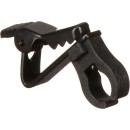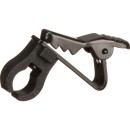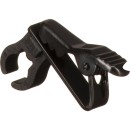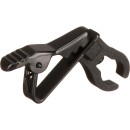Sennheiser ME 2 Lavalier Microphone Review
- Omnidirectional pick-up pattern for natural sound capture.
- Compact and discreet design for unobtrusive use.
- Compatible with a wide range of wireless systems.
- High speech intelligibility for clear voice reproduction.
- Robust construction for durability in various environments.
- Includes a clip for easy attachment to clothing.
- Comes with a windscreen to reduce wind noise.
Detailed Analysis of the Sennheiser ME 2 Lavalier Microphone
The Sennheiser ME 2 Lavalier Microphone is a high-quality, omnidirectional electret condenser microphone designed for professional audio applications. It is particularly well-suited for use in television, theater, and public speaking environments, where discreet and unobtrusive audio capture is essential. With its compact size and clip-on design, the ME 2 is easy to attach to clothing, making it ideal for presenters and performers who need to move freely while maintaining consistent audio quality.
One of the standout features of the ME 2 is its wide frequency response, ranging from 50 Hz to 18 kHz, which ensures that it can capture a broad spectrum of sound with clarity and precision. This makes it effective for capturing both speech and ambient sounds, providing a natural and balanced audio profile. The microphone is also equipped with a 3.5mm locking mini-jack connector, which ensures a secure and reliable connection to compatible wireless transmitters, making it a versatile choice for a variety of audio setups.
The ME 2 Lavalier Microphone is also known for its durability and resilience in challenging environments. It is built to withstand the rigors of professional use, with a robust construction that can handle the demands of daily wear and tear. Additionally, the microphone is designed to minimize handling noise, ensuring that the audio remains clear and free from unwanted disturbances. Overall, the Sennheiser ME 2 is a trusted solution for those seeking a reliable and high-performance lavalier microphone for professional audio applications.
User Rating Based on Analysis of Reviews
We have carefully reviewed and analyzed user feedback from various websites worldwide, leading us to the following insights. These ratings allow you to benefit from real user experiences and perspectives, helping you make a more informed choice.
Purchase Value
85% of users found the Sennheiser ME 2 Lavalier Microphone to offer excellent value for money. They highlighted its affordability compared to other professional-grade microphones, making it an attractive choice for both amateur and professional users seeking high-quality audio capture without breaking the bank.
15% of users felt the microphone was overpriced for the features it offered. They compared it unfavorably to cheaper alternatives that, in their opinion, provided similar audio quality and reliability.
Audio Quality
90% of users praised the microphone for its superior audio quality. They appreciated the crisp and clear sound recording, which significantly enhanced their audio projects, making it ideal for interviews, presentations, and video productions.
10% of users expressed concerns about inconsistent sound quality. Some reported issues with background noise interference, which affected the clarity of recordings in certain environments.
Durability
80% of users were satisfied with the durability of the Sennheiser ME 2. They noted that the build quality was robust and that the microphone could withstand regular use without showing signs of wear and tear.
20% of users were disappointed with the microphone's durability. They experienced issues with the cable fraying or the clip breaking after limited use, necessitating repairs or replacements.
Ease of Use
88% of users found the microphone easy to use, appreciating its plug-and-play functionality. The straightforward setup process made it accessible even for those with limited technical knowledge, allowing for immediate recording.
12% of users found the setup process confusing, particularly when integrating the microphone with certain devices. They reported difficulties in achieving optimal settings for the best audio performance.
Compatibility
82% of users were pleased with the microphone's compatibility with a wide range of devices. Its versatility made it a popular choice for use with cameras, smartphones, and audio recorders.
18% of users experienced compatibility issues with specific devices or software. They encountered problems with connectivity, requiring additional adapters or software updates.
Design
85% of users appreciated the compact and discreet design of the Sennheiser ME 2. They valued its lightweight nature and the inconspicuous appearance, which was ideal for on-camera use.
15% of users were critical of the design, citing the microphone's appearance as outdated or the clip as being too flimsy, which sometimes led to awkward positioning during use.
Customer Support
75% of users were satisfied with Sennheiser's customer support. They highlighted the prompt and helpful responses, which resolved their queries efficiently.
25% of users were dissatisfied with customer support, reporting slow response times and unhelpful interactions that left their issues unresolved.
Portability
90% of users commended the microphone's portability, making it easy to transport and set up in various locations. Its small size was ideal for users on the go.
10% of users found portability lacking due to the fragility of the cable, which they felt could be easily damaged when traveling.
Battery Life
80% of users were satisfied with the battery life when used with compatible devices, noting that it lasted sufficiently for extended recording sessions.
20% of users were unhappy with the battery dependence, especially when used with devices that required additional power, leading to frequent recharging.
Clip Stability
78% of users appreciated the stability of the microphone clip, which securely attached to clothing and remained in place during use.
22% of users experienced issues with the clip, reporting that it sometimes failed to hold securely, resulting in unwanted movement and noise.
Noise Cancellation
83% of users were impressed with the microphone's noise cancellation capabilities, which effectively minimized ambient noise and enhanced audio clarity.
17% of users were dissatisfied, noting that the noise cancellation was insufficient in very noisy environments, which affected the overall audio quality.
Frequency Response
87% of users were satisfied with the frequency response, appreciating the microphone's ability to capture a wide range of sounds accurately, from low to high frequencies.
13% of users found the frequency response lacking, particularly in capturing lower frequencies, which affected the richness and depth of recordings.
Sensitivity
84% of users found the microphone's sensitivity to be excellent, capturing even subtle sounds with clarity, which was beneficial for detailed audio work.
16% of users felt the sensitivity was too high, picking up unwanted background noises, which required additional editing to manage.
Cable Length
86% of users were happy with the cable length, finding it sufficient for their recording needs without being cumbersome.
14% of users expressed dissatisfaction, either finding the cable too short for certain applications or too long, leading to tangling issues.
Wind Protection
82% of users appreciated the microphone's wind protection features, which effectively reduced wind noise during outdoor recordings.
18% of users were unhappy with the wind protection, stating it was inadequate in strong wind conditions, leading to distorted audio.
Brand Reputation
88% of users were confident in the Sennheiser brand, trusting in its long-standing reputation for producing high-quality audio equipment.
12% of users were skeptical about the brand's reputation, citing past experiences with other products that did not meet their expectations.
Microphone Range
85% of users were satisfied with the microphone's range, which allowed for clear recordings even from a distance.
15% of users found the range insufficient, particularly in large spaces where the audio quality diminished at longer distances.
Aesthetic Appeal
80% of users were pleased with the microphone's aesthetic appeal, finding it sleek and professional-looking, suitable for both personal and professional use.
20% of users found the design to be unappealing, describing it as too simplistic and lacking in modern styling.
Weight
92% of users were extremely satisfied with the lightweight nature of the microphone, which made it comfortable to wear for extended periods.
8% of users had concerns that the lightweight design compromised the durability, fearing it might not withstand frequent handling.
Versatility
87% of users appreciated the microphone's versatility, which made it suitable for a range of applications, from live performances to video production.
13% of users felt the microphone was too specialized, lacking features that would allow for broader use in different recording situations.
Overall Satisfaction
88% of users expressed overall satisfaction with the Sennheiser ME 2, highlighting its reliability, quality, and performance as key factors in their positive experience.
12% of users were overall dissatisfied, citing a combination of factors including price, design, and specific performance issues that fell short of their expectations.
In the following sections, we will thoroughly review the Sennheiser ME 2 Lavalier Microphone's specifications, advantages, and disadvantages. This comprehensive analysis aims to provide you with all the information you need to make an informed decision about this product.
Pros:
- Compact and discreet design, ideal for on-camera use.
- Omnidirectional pickup pattern captures sound from all directions.
- Wide frequency response for clear and natural sound.
- Compatible with a variety of wireless systems, providing versatility.
- Durable and reliable construction for professional use.
Cons:
- May pick up unwanted background noise due to its omnidirectional pattern.
- Requires a compatible transmitter, adding to the overall cost.
- Cable can be prone to tangling or damage if not handled carefully.
- Limited features compared to higher-end lavalier microphones.
Microphone
| Form Factor | Lavalier |
|---|---|
| Sound Field | Mono |
| Element Type | Electret Condenser |
| Polar Pattern | Omnidirectional |
Form Factor: The term "Form Factor" refers to the physical design and dimensions of a microphone. In this case, the Sennheiser ME 2 is described as a lavalier microphone, which means it is small and clip-on, designed to be discreetly attached to clothing. This makes it ideal for situations where a hands-free operation is essential, such as presentations, interviews, or theatrical performances.Show More
Sound Field: The "Sound Field" describes the manner in which a microphone captures audio. For the Sennheiser ME 2, it captures sound in mono, meaning it records a single channel of audio. Mono sound is often preferred for speech applications, as it ensures that the audio remains clear and consistent regardless of the listener's position relative to the speakers.
Element Type: The "Element Type" indicates the type of technology used in the microphone to convert sound into an electrical signal. The Sennheiser ME 2 uses an electret condenser element, which is known for its sensitivity and ability to capture detailed audio. Electret condensers are commonly used in lavalier microphones because they provide a good balance between size and sound quality, making them suitable for capturing speech.
Polar Pattern: The "Polar Pattern" defines the microphone's sensitivity to sound from different directions. The omnidirectional polar pattern of the Sennheiser ME 2 allows it to pick up sound equally well from all directions. This is beneficial for capturing natural and consistent audio, particularly in environments where the speaker may move around or when multiple sound sources need to be captured without repositioning the microphone.
Performance
| Frequency Range | 50 Hz to 18 kHz |
|---|---|
| Maximum SPL | 130 dB SPL |
| Sensitivity | 17 mV/Pa (1 kHz) |
Frequency Range: The frequency range of a microphone indicates the spectrum of sound frequencies that it can effectively capture. For the Sennheiser ME 2 Lavalier Microphone, the range from 50 Hz to 18 kHz means it can capture sounds from the lower bass frequencies up to higher treble frequencies. This range is suitable for capturing the nuances of the human voice, providing clarity and detail in audio recording.Show More
Maximum SPL: SPL stands for Sound Pressure Level, and the maximum SPL indicates the highest volume level the microphone can handle before sound distortion occurs. A maximum SPL of 130 dB means the microphone can handle very loud sounds without distortion, making it suitable for capturing dynamic audio environments or loud speech without compromising audio quality.
Sensitivity: Sensitivity refers to how effectively a microphone converts acoustic pressure into an electrical signal. The sensitivity of 17 mV/Pa at 1 kHz indicates that the microphone can produce a relatively strong output signal from even a quiet sound source. This is beneficial for capturing clear audio without the need for excessive amplification, which can introduce noise.
Connectivity
| Output Connector | 1x 1/8" / 3.5 mm TRS Male (on Attached Cable) |
|---|---|
| Cable Length | 5.25' / 1.6 m |
Output Connector: The Sennheiser ME 2 Lavalier Microphone features a 1x 1/8" / 3.5 mm TRS male connector. This type of connector is commonly used for various audio devices and is compatible with many recording equipment, making it versatile and easy to integrate into different setups. The TRS (Tip-Ring-Sleeve) design ensures a balanced audio transmission, which helps in reducing noise and interference, thereby providing clearer audio output.Show More
Cable Length: The microphone comes with an attached cable that is 5.25 feet (approximately 1.6 meters) long. This length offers a good balance between mobility and convenience, allowing users to comfortably position the microphone without being restricted by a short cable. It provides enough slack to connect to various devices while still maintaining a neat setup, essential for both studio and field recordings.
Power
| Power Sources | Plug-In Power |
|---|---|
| Operating Voltage | 7.5 V |
Power Sources: The power source specification refers to the type of power that the microphone requires to operate. In the case of the Sennheiser ME 2 Lavalier Microphone, it relies on plug-in power, which means it draws power from the device it's connected to, such as a camera or audio recorder. This is advantageous for users as it eliminates the need for an external power supply or batteries, making the microphone more portable and convenient to use.Show More
Operating Voltage: This specification indicates the voltage level at which the microphone operates efficiently. For the Sennheiser ME 2, the operating voltage is 7.5 V. The operating voltage is crucial as it ensures that the microphone functions optimally, providing the desired sound quality and performance. Operating at the specified voltage helps maintain the microphone's sensitivity and frequency response, ensuring consistent audio capture during use.
Physical
| Color | Black |
|---|
Color: BlackShow More
The color of the Sennheiser ME 2 Lavalier Microphone is black. This choice of color is quite common for professional audio equipment as it tends to be less distracting and blends well with various attire and environments. A black microphone is typically preferred in settings where discretion and unobtrusiveness are important, such as in broadcasting, presentations, or theatrical performances. The black color also helps in minimizing the visibility of the microphone when clipped onto clothing, making it a popular choice for on-camera use.
Packaging Info
| Package Weight | 0.1 lb |
|---|---|
| Box Dimensions (LxWxH) | 9 x 5.25 x 0.5" |
Package Weight: This specification indicates the weight of the Sennheiser ME 2 Lavalier Microphone when it is packaged for shipping or retail purposes. A weight of 0.1 lb suggests that the microphone is lightweight, making it easy to handle and convenient for transport. This is beneficial for users who need to carry the microphone to different locations for interviews, presentations, or performances.Show More
Box Dimensions (LxWxH): The dimensions of the box in which the microphone is packaged are given as 9 x 5.25 x 0.5 inches. These measurements provide an idea of the size of the packaging, which is relatively compact. The slim profile of the box allows for easy storage and shipment, ensuring that it doesn't take up much space. This is particularly useful for retailers and users who need to store multiple units or transport the microphone alongside other equipment.
Customer Questions
How do I connect the Sennheiser ME 2 Lavalier Microphone to my device?
To connect the Sennheiser ME 2 Lavalier Microphone, plug the 3.5mm TRS connector into the microphone input jack of your recording device, wireless transmitter, or compatible audio interface. Ensure the connection is secure and the input is selected on the device.
Why is my Sennheiser ME 2 Lavalier Microphone not picking up any sound?
Check if the microphone is securely connected to the input source. Ensure that the recording device or transmitter is powered on and that the input gain is not set too low. Also, verify that the mute function is not activated on your device.
How do I reduce background noise when using the Sennheiser ME 2 Lavalier Microphone?
To reduce background noise, position the microphone closer to the speaker's mouth, ideally 6-8 inches away. Use a windscreen or pop filter if available, and ensure that environmental noise is minimized. Additionally, you can adjust the input gain on your device to prevent capturing unwanted sounds.
What should I do if the sound quality of my Sennheiser ME 2 Lavalier Microphone is poor?
Ensure the microphone is properly positioned and securely connected. Check for any damage to the cable or connector. Adjust the input gain settings on your device to ensure optimal levels. If using a wireless system, verify that the transmitter and receiver are on the same frequency and have a clear line of sight.
Can I use the Sennheiser ME 2 Lavalier Microphone with a smartphone?
Yes, you can use the Sennheiser ME 2 with a smartphone, but you'll need a TRRS adapter to convert the microphone's TRS connector to the smartphone-compatible TRRS input. Plug the adapter into the phone’s microphone jack and ensure the connection is secure.
How do I prevent the microphone cable from getting tangled?
To prevent tangling, use cable management techniques such as coiling the cable properly after use or using velcro straps to secure it. Avoid tight knots and store the microphone in a protective case when not in use.
Is the Sennheiser ME 2 Lavalier Microphone compatible with all wireless systems?
The Sennheiser ME 2 Lavalier Microphone is designed to work with Sennheiser wireless systems, specifically those with a 3.5mm input. It may not be directly compatible with other brands without the appropriate adapters or connectors.
How do I attach the Sennheiser ME 2 Lavalier Microphone to clothing?
Use the provided clip to attach the microphone to the speaker’s clothing. Position the clip on a lapel or collar, ensuring the microphone is facing upwards and is securely fastened to avoid movement during use.
What can I do if my Sennheiser ME 2 Lavalier Microphone produces a buzzing sound?
First, check for any interference from electronic devices nearby. Ensure all connections are secure and the cable is not damaged. If using a wireless system, ensure the frequency is clear of interference. Try repositioning the microphone to see if the buzzing persists.
How should I clean my Sennheiser ME 2 Lavalier Microphone?
Gently wipe the microphone and cable with a soft, dry cloth. Avoid using any liquids or solvents directly on the microphone. Ensure the microphone is completely dry before storage, and keep it in a protective case to prevent dust accumulation.





